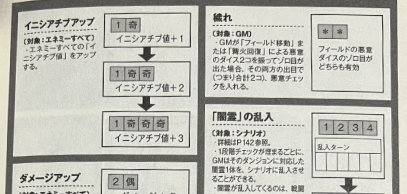Our deep dive into the Japanese Dark Souls TRPG continues with a look at the GM portion of the book. Part one covered the first half of the book, which focuses on player content. I’ve done my best to keep spoilers to a minimum, but I do show the data of the first enemy encountered in the tutorial scenario. The remaining three sections we’ll look at today are Scenarios, Enemies, and Charts and Sheets. After that there’s a quick look at the bonus GM screen.
Scenario Section
The scenario section begins with helpful advice for the GM and an overview of both solo and multi play. It continues with an overview of how scenarios work, mapping, treasure, and the ominous malevolence sheet.
The Scenarios
There are four sample scenarios provided. The first is a tutorial scenario to learn the rules for a single player, and the remaining three are for one to four players. Each scenario is summarized with its name, recommended number of PCs, character levels, and additional notes, such as when to use the Malevolence Sheet. These brief summaries are later expanded on with more details at the beginning of each scenario.
Mapping

Exploration is mapped using thirteen playing cards (Ace to King). The suit doesn’t matter, and can be the same or optionally used to signify locations, such as Hearts for bonfires. Each card represents a field, and can be closed (face down) or open (face up). Some fields have an exact position, while others are defined as a group of cards that make up an area. Each group of cards is shuffled and then placed randomly in the slots marked for that group.
There are three timings of field placement: initial, secondary, and midway. The initial placement is used at the start of the scenario. Certain scenarios have a secondary placement that replaces the first, which is used when conditions are met. Midway fields are added to the existing map when their conditions are met.
PCs can move between horizontal or vertically adjacent fields, but not diagonally. If the Malevolence Sheet is being used, the GM rolls to determine its effects each time the PCs move. The first time a player enters a field, they automatically receive a number of souls. After a player hears the description of the new location, they reach a checkpoint, which consists of multiple actions they can choose from.
Treasure
Ah, treasure chests. They always have treasure, but some will try to eat you. True to its source, the Dark Souls TRPG includes rules for mimic chests. Whether it is a mimic or not is randomly determined by the GM. There’s a ward that can protected against them, but if the PC doesn’t use it, they have two choices open the chest: open it without care or attack it. Attacking a chest gives advantage if it is a mimic, but if it is not, certain types of items inside will be destroyed.
Malevolence Sheet

Similar to memories, the malevolence sheet (悪意シート) is unique to the TRPG. It’s used when there are at least two PCs, and is intended to allow the GM to adjust game balance and increase tension as the story progresses. The sheet is visible to the players, and serves as a gauge.
Malevolence is generated at the start of the scenario, and then again as time passes. There are several malevolence options, each with a dice condition. The GM rolls a number of dice and adds a check to each condition that matches. Most begin with a single number that must match, but subsequent checkboxes are broader and match even or odd results. Others are arbitrary and may be chosen by the GM.
The effects of malevolence vary, but range from increasing enemy initiative or damage to making it harder for players to dodge. Each of these have several ranks that increase the effects as they are checked. The malevolence sheet is used to track when an invasion by a Red Phantom occurs. If a Red Phantom will invade, the GM rolls to determine when they arrive in combat.
Of Death and Lost Memories
While death and PCs losing all their memories was addressed in the player section, the scenario sections revisits them from the perspective of the GM. When all PCs die, they can respawn and retry the battle, but when all memories are lost, the PC is lost and the player must create a new PC. In the case of the host losing their memories, the scenario starts from the beginning. In the case of a White Phantom, the player creates a new character that can be summoned with a summoning sign.
One bit of advice is for PCs to give their expensive items to an ally if the PC is low on memories. That way if their character is lost, the nice items are safe. It is sound advice, but its directness to mechanical strategy surprised me, and highlights how the game expects players to engage with it.
It’s here that the first scenario “Cemetery of Ash” (灰の墓所) begins. I played this scenario solo, and will post a play report next time. For now, we’ll skip the 104 pages of scenario content and take a look at how enemies work.
Enemies

The enemies section begins with advice on how to use them, with a focus on writing your own scenarios. While combat is a core component of the game, it stresses that combat without role-play or problem solving becomes boring, and it should create tension.
After that, it details the amount of information players should know about enemies, and includes the rationale behind each recommendation. For example, the GM should tell players an enemy’s exact HP and initiative, but narratively describe their weaknesses and resistances as players discover them.
Next is how enemies operate. Unlike many RPGs, the GM does not decide an enemy’s actions in combat. Instead, they are determined randomly by rolling a D6 and checking the result against a chart. If there are multiple targets for the action, the target is determined randomly. While enemies have HP, they don’t have FP, nor use dice to perform actions. Many enemies come in multiple level versions, and some even have multiple forms. Once the first form’s HP reaches 0, the second form takes its place in battle.
Know your Enemy
Finally, two pages explain how to read the enemy entry. Each enemy, including last bosses, has one page dedicated to them. The page contains a lot of data, but organizes it logically and the format is quick to reference during play.

Let’s take a look at the first enemy: Grave Warden (墓守/亡者). They cower and hide in various. Wielding a weapon, they approach slowly and attack. There are two versions: level 5 and level 10. The stats are mostly the same, but the attack patterns differ, and the level 10 have better initiative and HP. Actions are cleanly laid out in a table with additional details beneath them.
Let’s take a look at their patterns. Level 5 Grave Wardens attack with a melee weapon that deals 35 damage on 1-3. On a 4 or 5, they grapple the PC and prevent them from moving. On a 6, they move to a safe area and fire a flame bolt with their crossbow. In contrast, the Level 10 Grave Warden attacks with a melee weapon dealing 40 damage on 1-2. On 3-4, they make their crossbow attack. On a 5-6 they summon up to two level 5 Grave Wardens.
Beneath the actions is data related to damage. Each enemy has a wounds chart that translates damage to HP lost by the attack. Defenses, resistances, weaknesses, and HP follow.
Finally, each enemy has a loot section. This specifies the number of souls obtained by defeating the enemy and a loot table if the PC succeeds searching the body.
There are a total of 36 enemies in the book. A mix of common, strong, and bosses. We’re now at the end of the main content, with reference material next.
Charts and Sheets

The final section of the Dark Souls TRPG consists of charts and sheets. There’s a level up table that goes up to level 40; a character sheet; a battle area sheet; two pages of gestures, and malevolence sheet. Designer notes follow the brief index.
Bonus: GM Screen

Similar to Dracurouge, I received a A4 sized three panel GM screen when I purchase my copy soon after release. I love its small compact size. The front has artwork front and center, with the turn flow chart on the left panel and tables for action, reaction, edge, and damage on the right panel. The back has the malevolence chart at the center, a quick reference table of contents for the book on the left, and GM-specific references on the right.

Wrap Up
Thanks for sticking with me through this deep dive of the Dark Souls TRPG. Check out my solo play report of the tutorial scenario to see how it works in practice!

